Updated on June 9, 2022
Writing a follow-up email for a qualified sales prospect that you don’t want to lose might be one of the most anxiety-evoking moments! At least for a sales rep during their sales outreach campaign. But deep inside we all know – it has to be done.
Follow-up is one of the most important steps in the entire sales process. It determines whether you will close that deal or not, and it directly affects your sales quota.
Will you pursue that lead and close the sale or you will start doubting yourself and write a lazy follow-up email just for the sake of it? It’s mostly on you, but if you’re aware of the follow-up statistics, you’ll know that giving up is not an option here.
Let’s get straight to the point.
Prepare the ground for your follow-up sales email
Before you even start writing the follow-up email template for the prospective clients that didn’t reply to you, stop and try to figure out why they didn’t?
A lot of things will depend on the initial email you sent. For example, if you have a low open rate, you will have to take a step back and check why is that so.
Start by looking at the results of the first sequence to know how to follow up accordingly.
Take a look at the email open rate of your initial email
The first sales email metric to track is your open rate. And this is the ideal time to do so.
You have sent a cold email outreach, received some results, now it’s time to analyze them so you know how to follow up.
Why people don’t open your cold emails?
If you have a really low open rate, but your cold email software tells you that all emails are delivered, you might have a bigger issue at hand.
Yes, your emails might be delivered, but where? In the inbox of your recipients or the spam folder?
One of the most recurring (and yet hidden!) reasons why people didn’t open your emails is that you might be sending them to their spam folder. 💡
And your sales follow-up emails are of no use if the recipients are not opening and reading them.
Therefore, before you send your next batch of follow-up emails, make sure that you stick to the email rules for cold outreach to prevent your emails from being marked as spam. And make sure that people receive them where they can see them, in their inboxes.
Take a look at your sales email subject line
Another reason why your email open rate is low might be a poorly written subject line. After all, that’s the first thing your potential clients see in their inbox and decide whether or not to open your email.
Probably your first email didn’t greet your prospects with the most appealing subject line. But there is always a second chance.
How to boost email open rate with a better follow-up process?
There is one follow-up trick here, that works great for us at Sales.Rocks.
Before you send your second follow-up email, divide your email list into two groups: openers and non-openers.
Openers: Prospects that opened your first mail.
Non-openers: Everyone that didn’t open your previous email.
And then create two different follow-up email templates for each group.
For the openers, follow up in the same email thread (RE: same subject line). They already saw your first email, so the obstacle to responding here probably lies somewhere else, not in the email subject line.
With the non-openers, start a new email thread and treat it as a “second chance at leaving a good first impression” – with a new subject line, this time more relevant to each prospect.
This follow-up email tactic works because it gives you a second shot at attracting your prospects’ attention, without having to remind them that you already tried once but failed.
You can avoid the uncomfortable feeling of being ignored and skip the entire “Hey, it’s me again, I tried to reach you once, but failed, I’m sure you must be busy but….” thing altogether.
They never saw your initial email anyway, so instead of starting off clingy in your follow-up email, try sending them a proper sales email, starting from a clean slate. The chances are, nobody will ever notice.
This time, invest more effort into writing a relevant and personalized subject line that will get your message through the door.
Get Personalized Email Subject Lines
that resonate with your prospects.
How to write a follow-up email that your prospects can’t ignore?
When it comes to writing a follow-up sales email, there are two main approaches you can take.
The traditional, and most widely used is “the reminder follow-up”, and you already know how it goes. You’re practically reminding prospects about your previous conversation, feeling like you’re bothering them.
That might be the reason why a staggering 70% of sales professionals give up after the first unanswered sales email, according to a survey by Yesware.
And yet 80% of the average sales process requires around five follow-ups to close the deal.
We’ve been practicing the traditional approach for over 3 years and got a lot of experience, but more or less the same results. So we decided to switch the mindset and change the narrative when writing follow-up sales emails.
The lead nurturing approach to writing follow-up email sequences
Start treating your sales follow-up chain as a lead nurturing sequence where you constantly add value with every new email you send.
This will change the mood from “bothering them” to “helping them out” and will motivate and inspire you to keep sending your follow-up emails, at least until you reach the fifth one.
If you manage to personalize the messages and address their pain points, this strategy will help you make it difficult for your prospects not to reply to you.
Follow-up sales sequence best practices
When it comes to following up with potential customer and expecting a response, you’ll need to consider their stage in your sales funnel, their current pain points and needs, and the right timing of your communication.
Here are some of the best practices that worked for us, to help you efficiently follow up with sales leads and prospects, build meaningful business relationshps and win sales.
#1. Segment your leads according to their stage in your sales funnel
Each stage in the buyer’s journey comes with its own challenges and goals that will drive your sales outreach. Segment your leads into the right stage so that you don’t treat them like one size fits all and follow up with even more precise messaging and consumer targeting.
a) Awareness stage (cold leads)
If your leads are in the awareness stage, they’re probably still researching information on solutions to their pain points and getting familiar with you and your company. In other words, they will need some time to be properly warmed up.
At this stage, your prospect might not be fully aware of a problem they need to solve and has a selection of ideas in mind but will need more information and experience to make a decision. This is your quest to share the knowledge that, in terms of your follow-up email translates into delivering them valuable and relevant information. Such as blog posts related to their pain points, industry news, and statistics, or inviting them to your webinar, podcast, industry event or to subscribe to your marketing newsletter.
Follow-up sales email template
Subject line: Hey [[first_name]], need a break from work? Take a look at this.
“Hey [[first_name]],
(Your name) here, account executive @ (your company).
The latest industry statistics claim that 72% of B2B professionals are most likely to share and receive useful content via email. It’s important to stay informed in our industry.
Are you one of them?
We recently wrote an article about the most common pain points a [[job_title]], like yourself face, and how to solve them. It’s a helpful resource that may prove useful to you.
It includes tackling the same struggles that a [[job_title]] goes through in their everyday workflow, so it would be greatly appreciated to receive some actual feedback from your perspective.
If you liked it, you can subscribe to our newsletter here to receive additional resources to help you stay in the game.
p.s. Maybe you didn’t have the chance to read my previous email. Similarly to this one, it includes some news you might find interesting.
Enjoy your day,
[signature]”
The best part with this follow-up email template is that it doesn’t even require much of a personalization apart from their first name and job title.
b) Consideration stage (warm leads)
If your leads are in the consideration stage they have probably already googled both, your services and those of your competitors. And according to HubSpot, 60% of buyers want sales assistance during the consideration stage.
To bring your company to the forefront of their choice, in this stage your follow-up email template will need to include your company’s USP – unique selling proposition. How your product or service differs from that of your competitors? What can you offer that your competitors can’t?
Mention a case study in your follow-up email template from a satisfied customer that have gone through similar challenges but managed to overcome them thanks to your software’s unique feature or your agency’s exceptional service.
Or inform them about your new feature or added benefits to an existing product, and how it may help them achieve their goals and objectives.
Other forms of content to include in your emails in this stage are ebooks, whitepapers, downloadable guides, personalized videos, or personalized landing pages. But to create a sense of urgency, you can include personalized promotional offers that only they can receive through this email communication from you.
Follow-up message template
Subject line: Hey [[first_name]], you don’t want to miss this email
“Hey [[first_name]],
(Your name) here, head of growth at (your company name), not sure if you remember me.
I wrote to you a while ago, and now I want to check in again because you fit all the checkboxes for gaining the most value out of our new product feature.
(a brief description of your new product feature)
We designed a promotional offer that targets [[job_title]] like yourself, working in the [[industry]], and which you can receive only through this email.
Schedule a call on my calendar here for a quick chat/product demo and get 50% off of your first subscription.
[signature]“
#2. Be relevant. Personalize your communication
Personalization is a norm in any email communication today. That is, if you want your emails to be opened, read, and converting. Using someone’s actual name in the subject line increases email open rates by 26%. And 50% of companies claim they increase customer engagement through email personalization.
But as with anything in business, those things that bring the most value are some of the most difficult to accomplish. Such as collecting information on your prospects that you can use to personalize the follow-up emails you send them.
The easiest way to gather this information is to get access to a B2B database that contains all the bits and pieces about your target accounts (companies) and the business professionals that work inside. Their names, email addresses, job titles, phone numbers, the industry they operate in, the technologies they use, the annual revenue they generate, how large or small their company is, who is the decision-maker/buying committee (hierarchy view), etc.
When you have this information, and it’s all beautifully connected with your cold email software, selling runs smoothly. Sales.Rocks includes all of that and more.
B2B Data + Cold Email Software
Personalization comes naturally.
#3. Use various communication channels (email + LinkedIn)
Leads have their own preferred way of communicating and you’ll need to adapt your outreach to their preferences.
Utilizing different channels as part of a unified multichannel outreach strategy drastically improves the overall outreach potential.
This way you double the chances of your message actually reaching your prospects. And it’s harder for them to miss your message if they receive it through multiple channels.
With each new channel, you insert into the mix, you get another chance at reaching your prospect = a greater chance of customer acquisition.
92% of B2B marketers and sales professionals use LinkedIn to find and engage their B2B audience. And it only makes sense since 80% of all B2B leads from social media come from LinkedIn.
Here’s how you can follow up with your sales leads on email + LinkedIn simultaneously, reaching out to them from the same follow-up sales sequence – on automation.
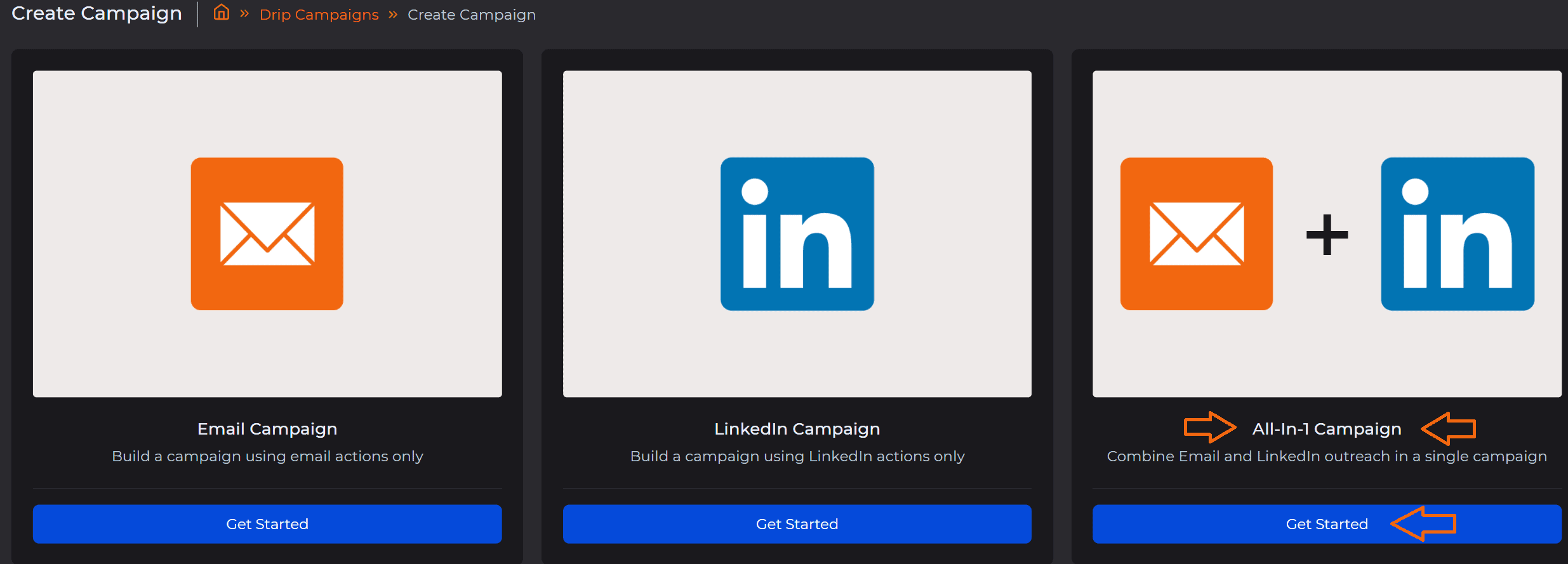
And the sales follow-up sequences become fun & interesting, instead of painful.
After you have collected your prospects’ email addresses and LinkedIn profiles, among the other information you have on them (job title, industry, etc.) you can then create a multi-channel outreach campaign.
Start with setting a LinkedIn action, such as visiting their LinkedIn profile. They will receive a notification about your visit and know you’ve looked them up. Sales.Rocks will do this from your LinkedIn profile on automation, leaving your hands free for more important tasks.
Next, set a delay for 1 day, giving them a chance to see you’ve visited their profile and remember your name. After that, follow up with another LinkedIn action: send connection request, with a short message.
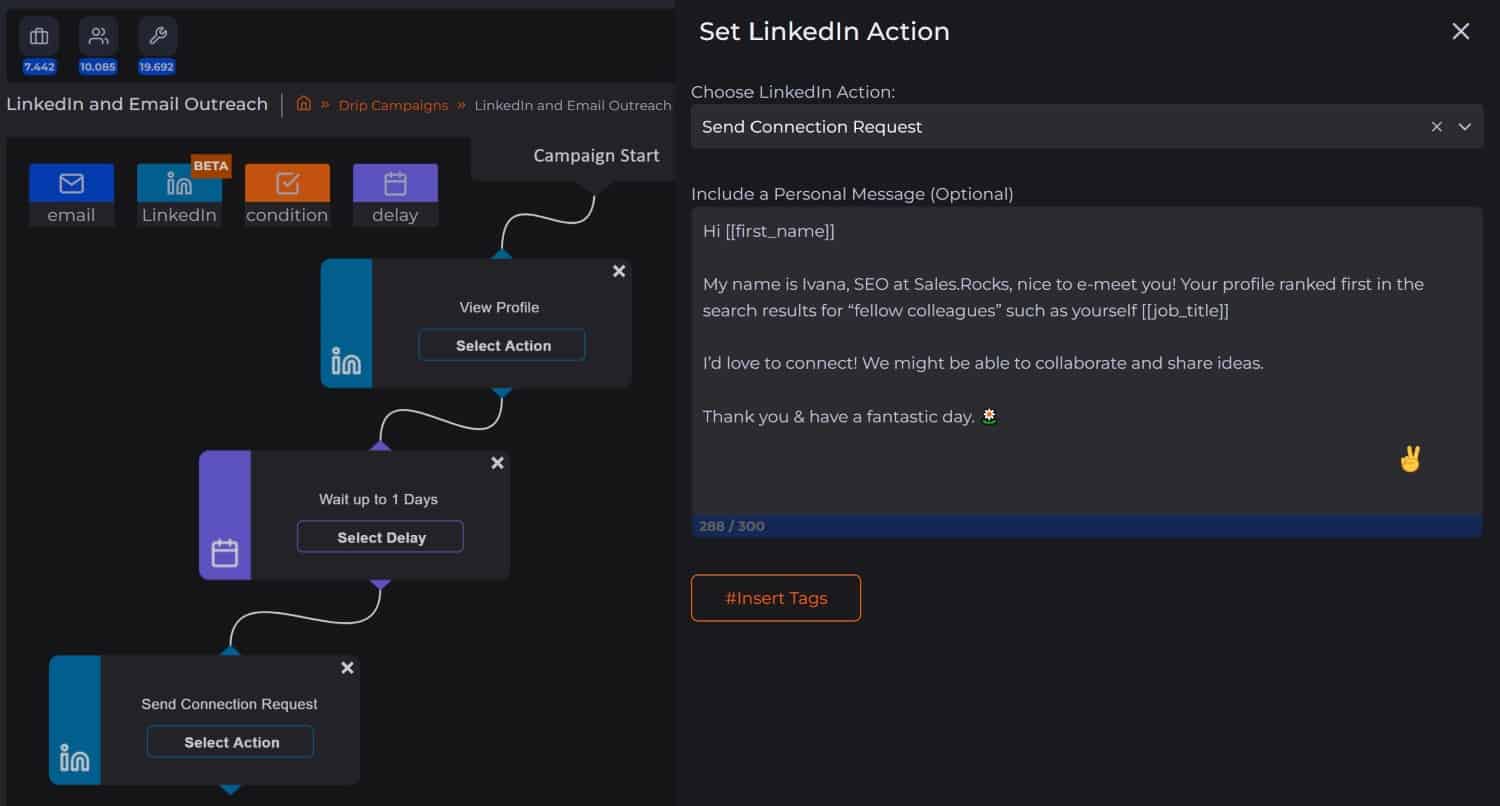
At this point, let them take their time to notice, open, accept and hopefully respond to your connection request by setting a delay of 1 day. 😇
After the day has passed, your automated follow-up campaign will check to see if they accepted your LinkedIn request. Here, there are two possible outcomes, to which you can set two different conditions.
Condition #1. They have accepted your LinkedIn connection request – so your follow-up action might be to like their most recent post on LinkedIn and send them a direct message!
Condition #2. They didn’t accept your request – but your smart follow-up sequence will send them an email to try your chances there. 🤞
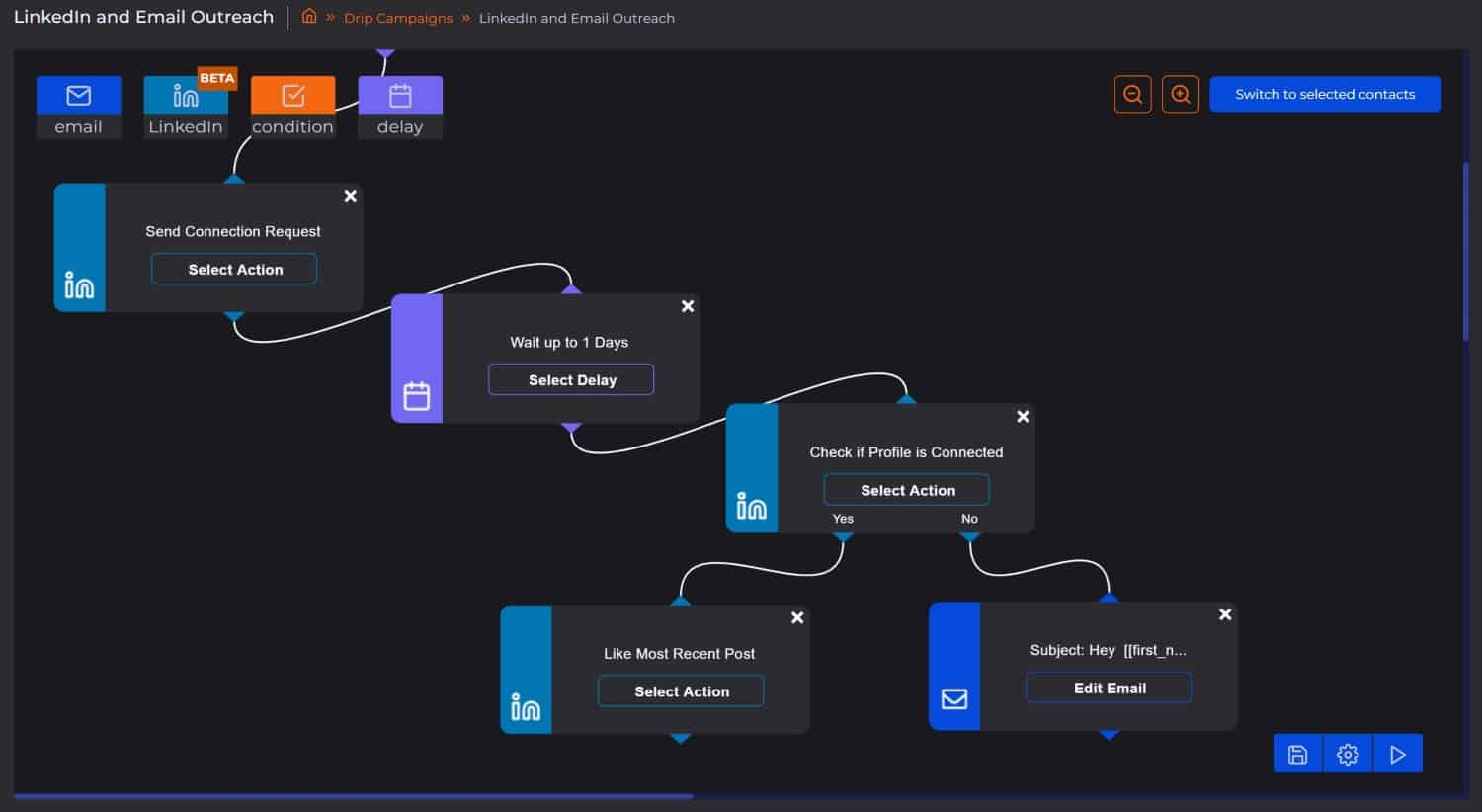
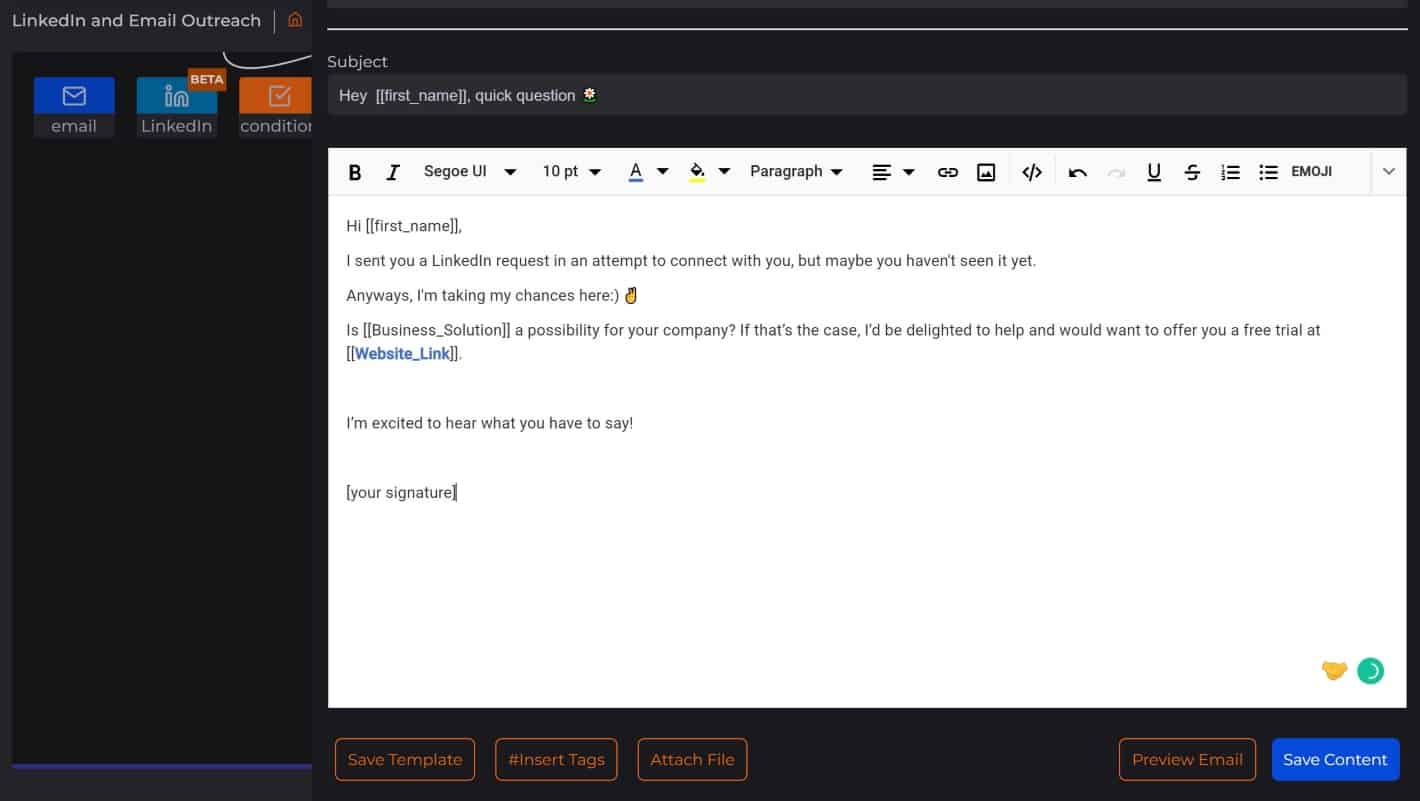
Then you wait again. This time, set a delay of 3 days, after which there are 3 case scenarios that might happen.
Condition #1. They opened the email.
Your email can address the missed opportunity to connect on LinkedIn, so there’s a high probability that they’ll check and either accept the connection request or not. Therefore, your next follow-up action is to check the LinkedIn connection again.
Condition #2. They clicked on the link you’ve included inside the email.
This could mean they took the next step and are scanning your company’s blog or landing page, or wherever you sent them via the link and checking your business out. In this scenario, you can expect a notification that you have received an email from them (or maybe not).
Condition #3. They did nothing.
Ok, it happens, nothing to worry about. There’s always a plan B – send another follow-up email!
Create a follow-up schedule that works the best for you and your ideal clients and be consistent until you reach them.
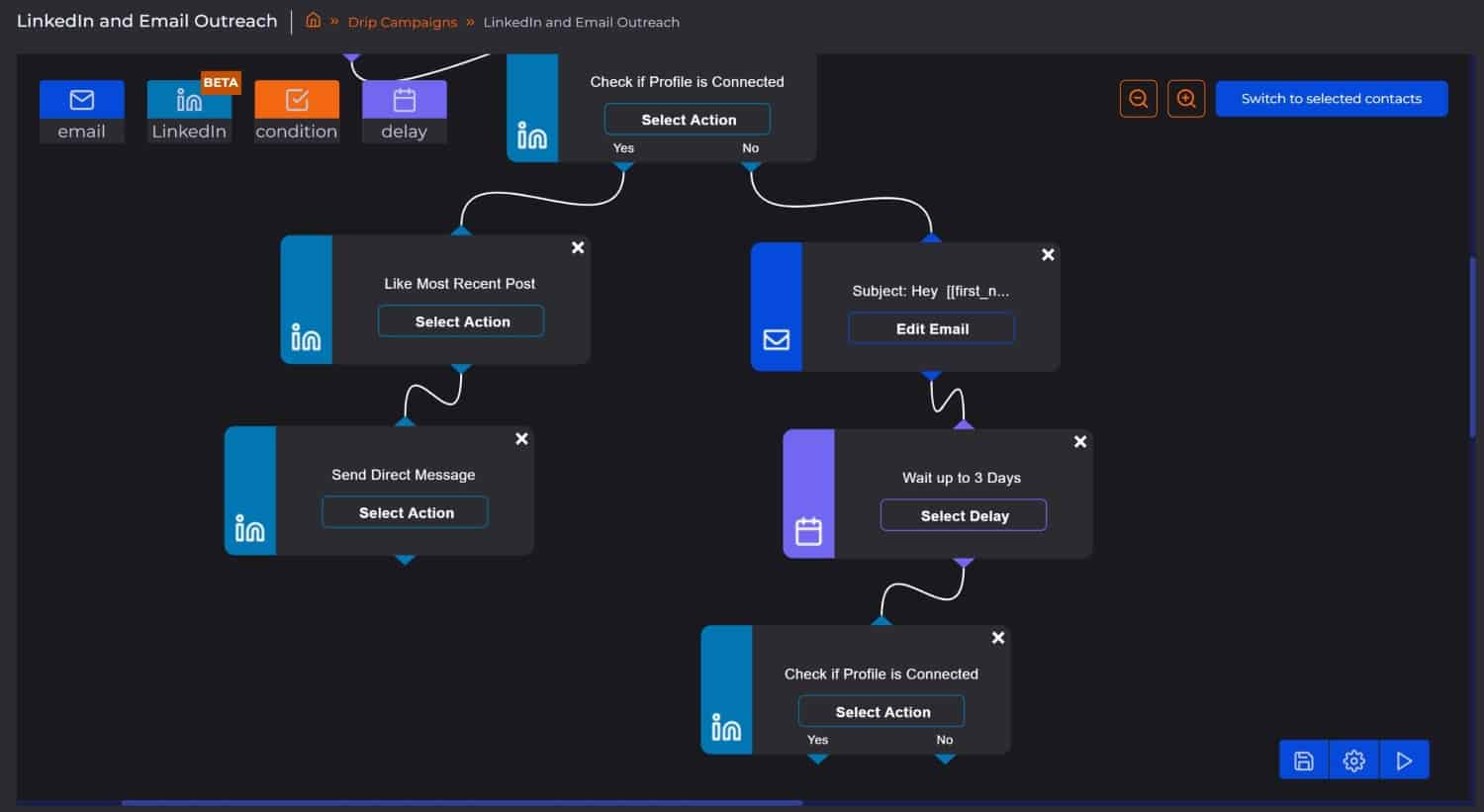
Wrapping up
Follow-up is probably the most important part of the sales process. B2B leads and ideal prospects that are the perfect match for what you offer are not infinite, and we take each of our potential prospects quite seriously.
Following the industry statistics, the findings show us again and again that the only way to reach your sales quota and hit your marks every time is to never give up. Your mindset plays a huge role in the success you’ll have with your follow-ups in sales.
Determination and persistence, coupled with the right sales tools to help you segment your leads and personalize your follow-up messages will make wonders for your business’s bottom line.


